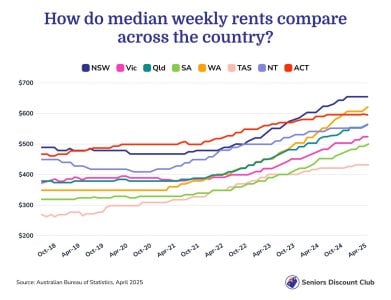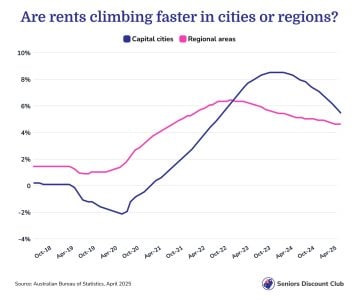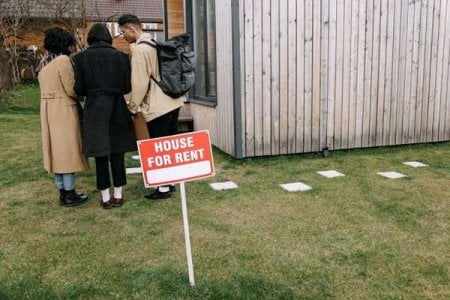Renters are torn over decisions about their rented property. Are you facing the same dilemma, too?
By
Danielle F.
- Replies 0
If you’ve been feeling the pinch whenever you pay your rent, you’re not alone.
Across Australia, the cost of renting has soared to record highs, leaving many Aussies wondering if it’s time to head for greener—and cheaper—pastures.
Let’s take a look at what’s happening and how Aussies, especially seniors, navigate the rental market.
According to the latest figures from the Australian Bureau of Statistics (ABS), rents have been climbing steadily since the COVID-19 pandemic,
Some rental properties in certain states saw increases of more than $250 a week compared to pre-pandemic rent prices.
Back in 2019, properties in New South Wales and the Australian Capital Territory (ACT) had median rents of $480 per week.
Fast forward to April 2025, NSW rent prices have surged ahead to $650 a week.
Western Australia, meanwhile, saw a steep jump, as rent prices have skyrocketed by 75 per cent, averaging $613 per week.
Tasmania, once considered a haven for affordable living, has not escaped the trend.
The Apple Isle’s median rent has climbed from $270 to $430 a week.
Is the grass greener outside the CBD?
City living often comes at a premium. However, during the COVID-19 pandemic, that old belief has been challenged.
With international borders closed and many people working from home, demand for city rentals dropped.
Vacancies in property rose, and rents in the capital cities fell for a while.
Meanwhile, regional areas saw a surge in demand as people sought a quieter lifestyle.
This pushed up rents in the regions and narrowed the gap between city and country living.

As of April 2025, annual rental inflation in capital cities eased to 5.5 per cent, down from a peak of 8.5 per cent in late 2023.
Regional rents also rose, but for many, they remain a more affordable option, especially for those who want peace and quiet.
Should you stay or should you go?
With rents rising everywhere, many Aussies ask themselves: is it cheaper to stay put, or should I make a move?
Rent increases have become larger and more common since the pandemic, no matter the area.
Since mid-2022, 80-95 per cent of properties with new tenants saw rent hikes compared to the previous lease.
This peaked at 94 per cent in early 2023 and has since eased to 83 per cent in April 2025.

Generally, those moving into a new property face bigger rent hikes than those who stay put.
Between June 2022 and June 2023, 70 per cent of new tenants copped rent increases of over 10 per cent.
Meanwhile, only 30 per cent of existing tenants saw hikes that steep.
The good news is that things are starting to ease again.
As of April 2025, 43 per cent of new tenants experienced a rent rise of more than 10 per cent, while another 10 per cent of tenants saw no change at all.
About 48 per cent of existing tenants had a rent rise under 10 per cent, and one in four had no increase at all.
What’s driving the rental squeeze? Here are several factors at play:
Regional areas often offer cheaper rental fees, a slower pace of life and a stronger sense of community.
For seniors who prefer a simpler, quieter life, it’s easier than ever to make the move.
However, it’s important to do your homework.
Some regional hotspots have seen rents rise at a sharp rate.
Make sure to research local amenities, healthcare, and transport options, especially if you’re considering a move in your later years.
For seniors who prefer to stay within the city, however, alternative living options have been on the rise as of late.
Retirement villages in Sydney are shifting away from traditional ground-level layouts towards high-rise buildings.
Vertical retirement villages are becoming popular, with eight out of ten new developments now consisting of high-rise apartments.
Tips for navigating the rental market

We would love to hear from you! Have you recently moved out of a capital city to find a better rental deal? Or are you staying put? Share your experiences with us in the comments section below. Your story could help a fellow member make their next big move!
Across Australia, the cost of renting has soared to record highs, leaving many Aussies wondering if it’s time to head for greener—and cheaper—pastures.
Let’s take a look at what’s happening and how Aussies, especially seniors, navigate the rental market.
According to the latest figures from the Australian Bureau of Statistics (ABS), rents have been climbing steadily since the COVID-19 pandemic,
Some rental properties in certain states saw increases of more than $250 a week compared to pre-pandemic rent prices.
Back in 2019, properties in New South Wales and the Australian Capital Territory (ACT) had median rents of $480 per week.
Fast forward to April 2025, NSW rent prices have surged ahead to $650 a week.
Western Australia, meanwhile, saw a steep jump, as rent prices have skyrocketed by 75 per cent, averaging $613 per week.
Tasmania, once considered a haven for affordable living, has not escaped the trend.
The Apple Isle’s median rent has climbed from $270 to $430 a week.
Is the grass greener outside the CBD?
City living often comes at a premium. However, during the COVID-19 pandemic, that old belief has been challenged.
With international borders closed and many people working from home, demand for city rentals dropped.
Vacancies in property rose, and rents in the capital cities fell for a while.
Meanwhile, regional areas saw a surge in demand as people sought a quieter lifestyle.
This pushed up rents in the regions and narrowed the gap between city and country living.

Source: Australian Bureau of Statistics, April 2025
Post-COVID-19, rents in the capitals are still high, but the rate of increase has slowed.As of April 2025, annual rental inflation in capital cities eased to 5.5 per cent, down from a peak of 8.5 per cent in late 2023.
Regional rents also rose, but for many, they remain a more affordable option, especially for those who want peace and quiet.
Should you stay or should you go?
With rents rising everywhere, many Aussies ask themselves: is it cheaper to stay put, or should I make a move?
Rent increases have become larger and more common since the pandemic, no matter the area.
Since mid-2022, 80-95 per cent of properties with new tenants saw rent hikes compared to the previous lease.
This peaked at 94 per cent in early 2023 and has since eased to 83 per cent in April 2025.

Source: Australian Bureau of Statistics, April 2025
Existing tenants haven’t been spared either, as 82 per cent of renters who stayed in their homes experienced a rent increase by late 2023.Generally, those moving into a new property face bigger rent hikes than those who stay put.
Between June 2022 and June 2023, 70 per cent of new tenants copped rent increases of over 10 per cent.
Meanwhile, only 30 per cent of existing tenants saw hikes that steep.
The good news is that things are starting to ease again.
As of April 2025, 43 per cent of new tenants experienced a rent rise of more than 10 per cent, while another 10 per cent of tenants saw no change at all.
About 48 per cent of existing tenants had a rent rise under 10 per cent, and one in four had no increase at all.
What’s driving the rental squeeze? Here are several factors at play:
- Population growth: Australia’s population has rebounded post-pandemic, with more people competing for the same number of homes.
- Limited supply: Construction delays and a lack of new housing have kept supply tight.
- Investor uncertainty: Some property investors have sold up, reducing the number of rental properties available.
- Cost of living pressures: Rising interest rates and inflation have pushed up costs for landlords, many of whom pass these on to tenants.
Regional areas often offer cheaper rental fees, a slower pace of life and a stronger sense of community.
For seniors who prefer a simpler, quieter life, it’s easier than ever to make the move.
However, it’s important to do your homework.
Some regional hotspots have seen rents rise at a sharp rate.
Make sure to research local amenities, healthcare, and transport options, especially if you’re considering a move in your later years.
For seniors who prefer to stay within the city, however, alternative living options have been on the rise as of late.
Retirement villages in Sydney are shifting away from traditional ground-level layouts towards high-rise buildings.
Vertical retirement villages are becoming popular, with eight out of ten new developments now consisting of high-rise apartments.
Tips for navigating the rental market
- Negotiate: If you’re a good tenant, don’t be afraid to negotiate with your landlord for a fairer deal.
- Consider downsizing: A smaller place or shared accommodation could help cut costs.
- Look beyond popular picks: Suburbs just outside the city or lesser-known regional towns may offer better value.
- Check for concessions: Seniors and pensioners may be eligible for rental assistance or concessions—check with your state government.
Key Takeaways
- Rents have surged across Australia since the pandemic, with the biggest jumps seen in Western Australia and NSW.
- While rents are generally still cheaper in regional areas, the price gap has narrowed in recent years as regional rents also rose.
- Rent increases have become widespread, affecting both new and existing tenants.
- Although rental inflation has eased from its peak, renters moving into a new property are still more likely to cop larger increases, while existing tenants could face rises below 10 per cent.








